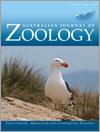The endemic Pacific gull (Larus pacificus) is Australia’s largest larid, and though little is currently known of its foraging ecology, its size and wide distribution suggest that it may play an important role within the marine environment. In the present study, regurgitate pellets collected from Seal Island in northern Bass Strait were used to compare intra- and interannual trends in diet composition. The main taxa identified in pellets were the common diving-petrel (Pelecanoides urinatrix), leatherjacket species (Family Monacanthidae), short-tailed shearwater (Puffinus tenuirostris) and mirror bush (Coprosma repens). Analysis of similarity (ANOSIM) identified no significant differences in numerical abundance of the dominant prey species between years, suggesting that the prey base in this region is temporally consistent or that the gulls consume low enough numbers to be unaffected by fluctuation in prey populations. Diving-petrels were consumed in consistently high numbers, suggesting the gulls may be an important predator of this species, or that the gulls are particularly skilled at foraging for them.
How to translate text using browser tools
5 June 2014
The diet of Pacific gulls (Larus pacificus) breeding at Seal Island in northern Bass Strait
Tamara N. Leitch,
Peter Dann,
John P. Y. Arnould
ACCESS THE FULL ARTICLE

Australian Journal of Zoology
Vol. 62 • No. 3
August 2014
Vol. 62 • No. 3
August 2014




